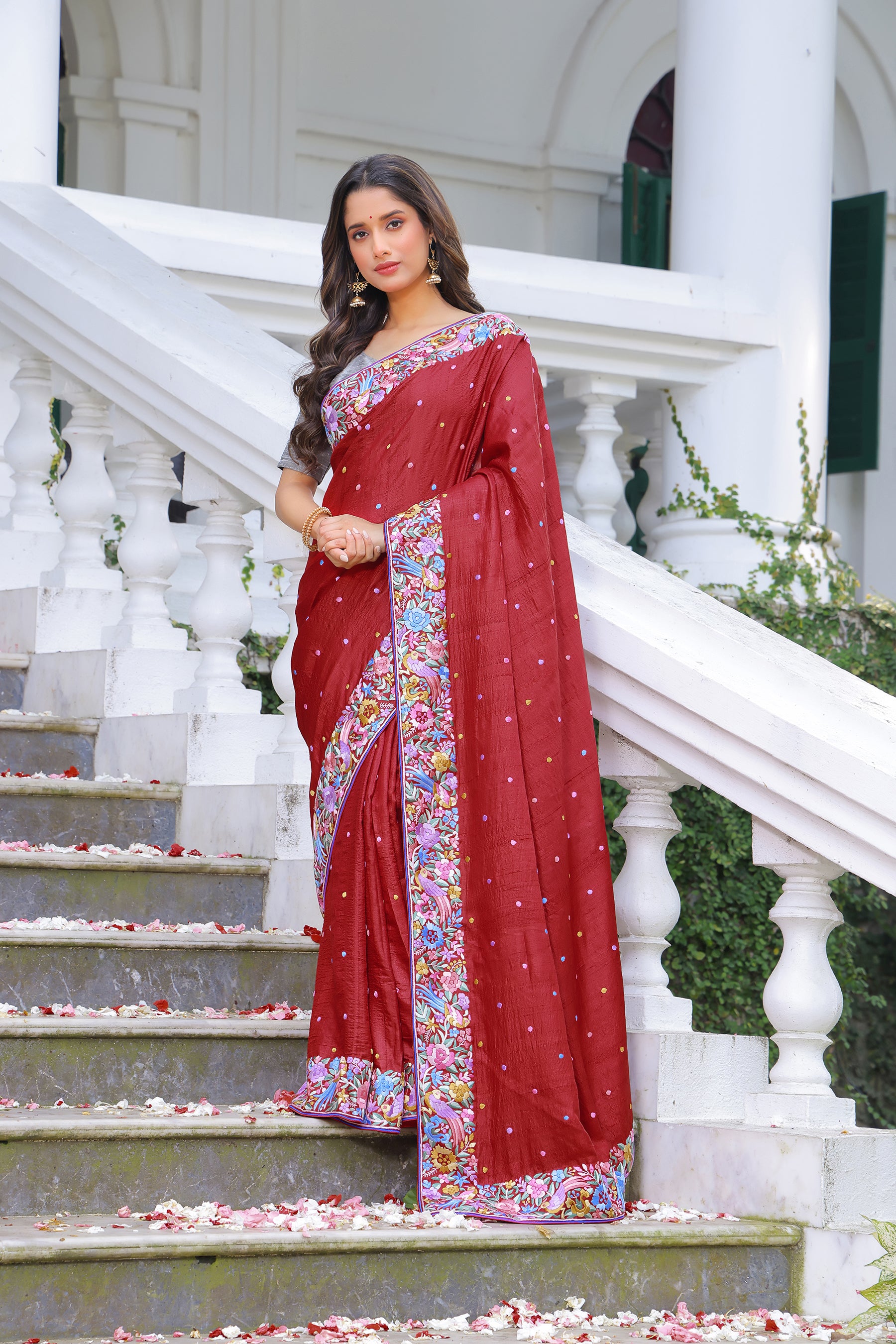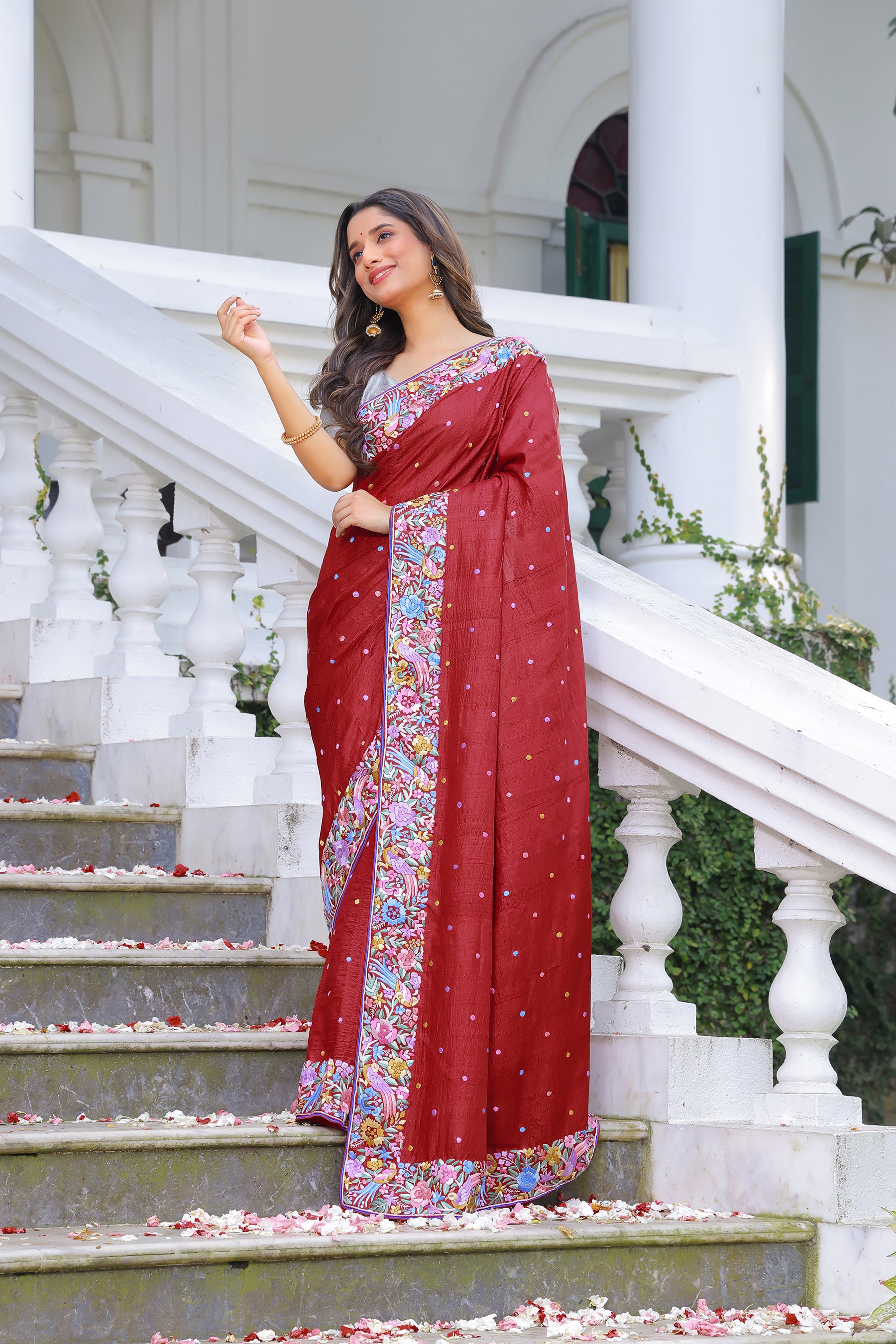A Tussar Hand Parsi Gara Saree is a beautiful and rare fusion of Tussar silk fabric and the traditional Parsi Gara embroidery. This saree brings together the luxurious texture of Tussar silk and the intricate, culturally rich Gara embroidery that has been a hallmark of the Parsi community for generations. The saree is cherished for its timeless appeal, exquisite craftsmanship, and intricate detailing, making it a popular choice for weddings, cultural celebrations, and other festive occasions.
1. Tussar Silk:
-
Tussar silk (also called Kosa silk) is a type of wild silk produced by silkworms that are not farmed but instead gather naturally from oak and other leaves. This silk is coarser and has a natural, earthy texture compared to other silks such as Mulberry silk.
- The fabric has a subtle sheen, which is not as glossy as other silks, but instead gives the saree a more matt finish, making it suitable for both day and evening wear. It is also known for its lightweight nature and breathability, making it comfortable for long hours of wear.
- Tussar silk is available in a variety of natural colors, from beige and gold to rich hues of brown, red, and rust, and often features intricate weaves that add texture and depth to the fabric. Its slightly textured surface also helps hold embroidery and embellishments beautifully.
2. Parsi Gara Embroidery:
-
Parsi Gara embroidery is a traditional form of hand embroidery practiced by the Parsi community in India, particularly in Mumbai and Gujarat. Gara embroidery is known for its intricate, colorful patterns and the use of silk threads, zari (gold or silver threads), beads, and sequins.
- The word “Gara” is derived from the Persian word for “flower” or “garden”, and the embroidery often features floral, bird, and paisley motifs that are meticulously hand-stitched into the fabric.
- The designs of Parsi Gara are inspired by Persian, Chinese, and Indian art forms, reflecting the Parsi community's rich cultural and historical influence. The embroidery is usually done in vibrant colors and adds a luxurious, ornate look to the fabric.
- Traditionally, Gara sarees were designed for weddings and celebrations, with heavy embroidery on the border and pallu (the loose end of the saree). The motifs often tell stories, with floral vines, birds, and even butterflies representing themes of life, love, and prosperity.
3. Tussar Hand Parsi Gara Saree:
- A Tussar Hand Parsi Gara Saree is a marriage of the natural elegance of Tussar silk and the intricate Parsi Gara embroidery. The soft, textured feel of Tussar silk provides a beautiful backdrop for the vibrant, intricate designs of Gara embroidery, creating a striking contrast between the fabric and the handwork.
-
The embroidery typically features floral, paisley, and vintage Chinese patterns, often in rich colors like red, gold, green, blue, black, and yellow, which add vibrancy and depth to the saree. The intricate embroidery work can be found along the borders, pallu, and sometimes all over the saree, depending on the design and the occasion.
- The Tussar silk’s natural texture makes the embroidery stand out, giving it a rich, regal appeal. The Parsi Gara motifs are often worked with zari threads, silk threads, and sometimes mirror work, creating an ethereal glow and making the saree a statement piece.
- The pallu of the saree is usually the focal point of the embroidery, featuring the most elaborate motifs and designs, while the border might have smaller, repeating motifs that complement the main designs.
4. Features of Tussar Hand Parsi Gara Saree:
-
Luxurious Fabric: The Tussar silk provides a rich, earthy look with its subtle sheen and textured surface, making it a perfect canvas for the elaborate Parsi Gara embroidery.
-
Intricate Hand Embroidery: The Gara embroidery is done by hand and requires exceptional skill and craftsmanship. The embroidery is often dense and features intricate designs that cover the borders and pallu of the saree, adding to its regal and opulent feel.
-
Traditional Appeal: This saree is a beautiful blend of traditional art forms, with Persian and Indian influences in the design motifs. It is perfect for those looking for a saree that represents heritage and cultural history.
-
Vibrant and Rich Colors: The Gara embroidery features bold, vibrant colors that contrast beautifully with the natural tones of Tussar silk. The combination of rich silks and gold or silver zari work gives the saree a timeless, elegant look.
-
Handcrafted Masterpiece: Each Tussar Hand Parsi Gara Saree is a handcrafted masterpiece, showcasing the art of hand-weaving and hand-embroidery. These sarees take hours, if not days, to create due to the labor-intensive embroidery process.
5. Popular Occasions to Wear:
-
Weddings: A Tussar Hand Parsi Gara Saree is a perfect choice for brides and bridesmaids, especially in the Parsi community. The opulence of the Gara embroidery makes it ideal for wedding functions such as the sangeet, reception, and wedding day.
-
Festivals: This saree is also an excellent choice for traditional festivals such as Diwali, Navratri, Eid, and Durga Puja, where it can be worn with style and grace.
-
Cultural Gatherings: The intricate and artistic nature of the Gara embroidery makes this saree ideal for cultural celebrations and family gatherings, where one wishes to make a statement.
-
Formal Occasions: The luxurious appeal of a Tussar Hand Parsi Gara Saree makes it perfect for formal events, gala dinners, and high-profile occasions where you want to stand out with traditional elegance.
-
Bridal and Reception: As a bridal saree or for a reception, this saree works well due to its classic richness, timeless appeal, and ethereal embroidery.
Conclusion:
A Tussar Hand Parsi Gara Saree is the epitome of luxury and heritage, combining the earthy elegance of Tussar silk with the intricate, colorful beauty of Parsi Gara embroidery. This saree is perfect for weddings, festivals, and any occasion that demands a combination of grandeur and traditional craftsmanship. The soft texture of Tussar silk enhances the beauty of the vibrant Gara motifs, making it a statement piece that exudes sophistication and cultural richness. The saree’s delicate yet striking aesthetic ensures it remains a timeless addition to any wardrobe.













